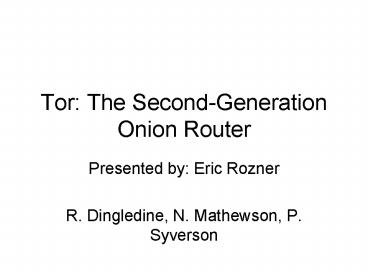Tor: The SecondGeneration Onion Router - PowerPoint PPT Presentation
1 / 27
Title:
Tor: The SecondGeneration Onion Router
Description:
Onion Routing: a distributed overlay network designed to anonymize TCP-based applications ... Overlay of Onion Routers routes used to route traffic ... – PowerPoint PPT presentation
Number of Views:1031
Avg rating:3.0/5.0
Title: Tor: The SecondGeneration Onion Router
1
Tor The Second-Generation Onion Router
- Presented by Eric Rozner
- R. Dingledine, N. Mathewson, P. Syverson
2
Roadmap
- Intro
- Design Goals/Assumptions
- Tor Design
- Attacks
- Tor in the Wild
- Conclusions
3
Introduction
- Circuit-based, low-latency anonymous
communication service - Onion Routing a distributed overlay network
designed to anonymize TCP-based applications - Tor provides benefits over previous onion routing
protocols
4
Benefits
- Perfect forward secrecy
- Telescoping path-building design, keys refreshed
- Better deployability
- SOCKS
- No mixing, padding, or traffic shaping
- Many TCP streams can share one circuit
- Less overhead
- Leaky-pipe circuit topology
- Traffic can depart anywhere in circuit, traffic
shaping and volume attacks become harder
5
Benefits Continued
- Congestion Control
- Directory servers
- No more flooding state through network
- Variable exit policies
- Different users comfortable with different levels
of involvement - End-to-end integrity checking
- Rendezvous points and hidden services
6
Design Goals
- Deployability
- Usability
- Flexibility
- Test-bed for future research
- Simple Design (well-understood, provable)
- All in an effort to increase participation
7
Assumptions
- Adversary doesnt have global view of network
- Adversary cant observe both ends of
communication - If timing and volume patterns of traffic are
distinct, a passive listener can infer Alice is
talking to Bob - Rather than focusing on these traffic
confirmation attacks, we aim to prevent traffic
analysis attacks, where the adversaary uses
traffic patterns to learn which points in the
network he should attack.
8
Tor Design
- Overlay of Onion Routers routes used to route
traffic - Onion Routers (OR) route traffic through the
overlay - Maintains long-term identity key
- Short term onion key
- Onion Proxy (OP) on client multiplex TCP
connections across circuits in overlay - Creates cells for communication over circuits
9
Tor in a nutshell
10
Nutshell
11
Nutshell
12
Cells
- Control Cells
- Creating and destroy a circuit
- Relay Cells
- Carry end-to-end stream data
- Control stream, data, open/close stream, extend
circuits, etc.
13
Circuit construction
- Constructed incrementally
- OP negotiates a symmetric key with each OR on the
circuit, one hop at a time - ORs only know previous and next hop
- Authentication, forward secrecy, key freshness
14
Example
- Encryption using Onion keys
15
Relay Cells
- Sending to an OR Alice assigns a digest,
iteratively encrypts the cell payload with the
symmetric key of each hop up to that OR - ORs decrypt payload and either forward or
process (if digest suceeds) - Leaky pipe
- ORs reply Encrypts cell with session key and
sends back toward Alice along the circuit.
Subsequent ORs add further layers of encryption. - OP at Alice will unwrap each level of encryption
16
Integrity Checking
- At each end-point of circuit
- SHA-1 digest is derivative of key that Alice
negotiates with each new hop - Only those two know it
- Prevents and adversary from modifying data
17
Rate limiting
- Tor uses a token bucket approach to enforce a
long-term average of incoming bytes - Volunteers dont have to give up all their
bandwidth to run Tor
18
Congestion Control
- Circuit-level throttling
- Packaging window how many cells the OR can
package back to OP - Delivery window how many data cells can be
forwarded to outside of network - Stream-level throttling
- Similar to above, end-to-end
- Both relay on acknowledgement scheme to move
window
19
Rendezvous Points and Hidden Services
- Allows some user to provide a service anonymously
- Both end-points remain anonymous
- Both parties connect via a third party, the
rendezvous point
20
Hidden Services
21
Hidden Services
22
User Participation
- Exit policies
- Open exit
- Middleman exit
- Private exit
- Restricted exit
- Abuse of open exit nodes a problem
23
Directory Servers
- Maintain state about whole network (doesnt
scale) - New nodes manually approved by system
administrators - Need to be trusted
- A compromised server breaks Tor
24
Attacks
- Passive attacks
- Probably not hard to tell a node is running Tor
- Active attacks
- DDoS, running an onion proxy, router
- Directory attacks
- Destroy or subvert directory servers
- Rendezvous points
- Attack RP or introduction points
25
DOS
- DOS against induction points
- DOS against a circuit
- Circuit failure breaks all streams passing
through that circuit
26
Tor in the Wild
- 32 nodes
- Small, can still experiment and change
- Lookup of cnn.com (normally 0.3sec)
- Median 2.8 sec, 90 finished in 5.3 sec
- Will have to ensure scalability
27
Conclusions
- A lot of future work needed
- Still a lot of open questions
- Routing questions
- Padding needed?
- Too brittle?

